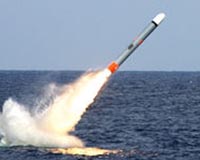| . |  |
. |
Tel Aviv, Israel (UPI) May 21, 2010 Israel, facing the threat of a massive missile attack by Iran and its proxies, breathed a sigh of relief after the U.S. Congress overwhelmingly approved giving it $205 million to buy 10 batteries of a new missile-defense system. The architect of the U.S. move was Israel's defense minister, Ehud Barak, the nation's most decorated war hero and a former chief of staff. He was also prime minister a decade ago and ordered the unilateral withdrawal of Israel forces from the so-called "security zone" in southern Lebanon after a 22-year occupation. Ten years after that pullback, Israelis are still arguing about whether it should ever have taken place. Many critics say it left Israel vulnerable, and the missile bombardment by Hezbollah in the 2006 war, the first time the Israeli hinterland had come under such sustained bombardment, would seem to substantiate that. Now, Israeli commanders say Hezbollah has some 45,000 missiles and rockets, four times the number it had when the 34-day 2006 war began. On top of that, many of Hezbollah's missiles, such as the Syrian-produced M600 ballistic weapon and the Iranian Zelzal, can hit targets anywhere in Israel. Iron Dome was deployed in January. But critics say it is seriously flawed and incapable of providing a credible defense against the short-range rockets, such as the Soviet-era Katyushas used by Hezbollah or the Qassam rockets made by Hamas technicians in the Gaza Strip, it is designed to counter. To make matters worse, the Defense Ministry had only allocated funds for developing the system, made by state-owned Rafael Advanced Defense Systems, and buying two batteries, preferring to give priority to the military's offensive readiness. Given the unprecedented scale of the threat Israel now faces from a new kind of war, two batteries is woefully inadequate. There are indications that the funding has political overtones. Barak led the charge in pressing Washington to come to Israel's aid with a one-time allocation of funds, on top of the $3 billion a year Israel gets in U.S. military aid. Barak has close relations with the administration of U.S. President Barack Obama, unlike his longtime rival, right-wing Prime Minister Binyamin Netanyahu. The hawkish Netanyahu has angered the White House by refusing to impose a freeze on West Bank settlement activity, which Obama wants to get peace talks going again. Obama endorsed Barak's request and Congress, which is heavily pro-Israel, swiftly approved the funding with a 410-4 vote Thursday. "The timing of the Pentagon announcement of President Obama's request comes a few days after Barak's audible suggestions that the Netanyahu government needs to be widened," Israel National News reported. White House officials deny that Obama is seeking to undermine Netanyahu and bring down his coalition government in favor of former foreign minister Tzipi Livni, leader of the centrist Kadima Party. The effusive welcome accorded Barak in Washington three weeks ago was in sharp contrast to the icy greeting Obama gave Netanyahu several weeks ago. So, overall, the infusion of funding for Iron Dome is widely seen in Israel as a political coup for Barak. But in terms of Israel's ability to effectively counter the missile threat, the funding will not provide an overnight solution. It will take at least a year for Rafael to produce the 10 new batteries of Iron Dome, each of which costs $25 million. Iron Dome is the bottom level of a planned three-tier missile defense shield that is still only partially in place. The Arrow-2 interceptor, built by state-owned Israel Serospace Industries and Boeing, will handle the long-range, high-altitude ballistic missiles such as Iran's Shehab-3B and Sejjil-2, while the midrange sector will be covered by a system known as David's Sling. But this system, also known as Magic Wand, is still being developed by Rafael and the U.S. defense giant Raytheon, and is unlikely to be operational for at least another two years. "It is far from clear that the Israel Defense Force has a good answer for a situation in which massive, accurate rocket fire shuts down ports and airports, impedes the operation of air force bases and forces the reserves to convene under heavy fire -- or whether the home front, and the politicians, will have the stamina to hold out until an offensive produces substantive military gains," commentator Amos Harel wrote in the liberal Haaretz daily.
Share This Article With Planet Earth
Related Links Learn about missile defense at SpaceWar.com All about missiles at SpaceWar.com
 Tomahawk Remote From 5,000 Miles Away
Tomahawk Remote From 5,000 Miles AwayUSS Cheyenne, At Sea (SPX) May 20, 2010 Los Angeles-class attack submarine USS Cheyenne (SSN-773) in conjunction with Commander, U.S. 7th Fleet and members of Naval Special Warfare Group (NSWG) 3 successfully fired a Block IV-E Tomahawk Land Attack Missile. The missile launch took place off the southern coast of California into China Lake Test Range and marks the first time a forward-deployed operational command acted as the Tom ... read more |
|
| The content herein, unless otherwise known to be public domain, are Copyright 1995-2010 - SpaceDaily. AFP and UPI Wire Stories are copyright Agence France-Presse and United Press International. ESA Portal Reports are copyright European Space Agency. All NASA sourced material is public domain. Additional copyrights may apply in whole or part to other bona fide parties. Advertising does not imply endorsement,agreement or approval of any opinions, statements or information provided by SpaceDaily on any Web page published or hosted by SpaceDaily. Privacy Statement |